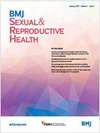妊娠中期手术流产前的宫颈准备与随后早产的风险
Q Medicine
Journal of Family Planning and Reproductive Health Care
Pub Date : 2016-12-22
DOI:10.1136/jfprhc-2016-101558
引用次数: 2
摘要
扩张排出术(D&E)是妊娠中期手术流产最安全的方法。与其他药物引产相比,它的直接并发症发生率较低,引起的疼痛和出血较少,而且更快、更便宜,是大多数妇女的首选除了选择性终止妊娠外,D&E在妊娠中期流产和产前胎膜破裂的有效管理中也起着重要作用。然而,在英国国家卫生服务(NHS)中,获得D&E的机会是不够的。虽然没有最近公布的数据,但堕胎服务提供者都知道,该国只有一家医院提供妊娠24周的D&E服务,而且只有极少数医院提供任何D&E服务。因此,许多妇女没有这种终止妊娠的选择,特别是由于产前胎儿诊断严重异常2或有复杂医疗问题需要住院治疗而选择终止妊娠的妇女。在NHS中,可能有很多障碍来改善D&E的使用,但根据我的经验,许多医生都担心对子宫颈的潜在损害,这可能导致后续怀孕的宫颈完整性降低。D&E要求……本文章由计算机程序翻译,如有差异,请以英文原文为准。
Cervical preparation prior to second-trimester surgical abortion and risk of subsequent preterm birth
Dilatation and evacuation, or D&E, is the safest method of second-trimester surgical abortion. It has a lower rate of immediate complications than the alternative of medical induction, causes less pain and bleeding, and is also faster, cheaper, and preferred by the majority of women.1 In addition to elective pregnancy termination, D&E has a role to play in the effective management of second-trimester miscarriage and pre-viable preterm pre-labour rupture of membranes.
However, access to D&E in the British National Health Service (NHS) is inadequate. Although no recent published data is available, it is common knowledge amongst abortion service providers that only one hospital in the country provides D&E to 24 weeks’ gestation, and only a very small minority of hospitals provide any D&E service at all. As a result, many women are not offered this option for termination, particularly women choosing a termination because of a seriously abnormal antenatal fetal diagnosis,2 or those with complex medical problems that require inpatient care.3
There are probably multiple barriers to improved access to D&E in the NHS, but in my experience many doctors are concerned about the potential for damage to the cervix, which could result in reduced cervical integrity for subsequent pregnancies. D&E requires …
求助全文
通过发布文献求助,成功后即可免费获取论文全文。
去求助
来源期刊

Journal of Family Planning and Reproductive Health Care
OBSTETRICS & GYNECOLOGY-
CiteScore
0.84
自引率
0.00%
发文量
0
审稿时长
>12 weeks
期刊介绍:
The trading of Professional, Managerial & Healthcare Publications Ltd has been transferred to its parent company, Keyways Publishing Ltd.
 求助内容:
求助内容: 应助结果提醒方式:
应助结果提醒方式:


